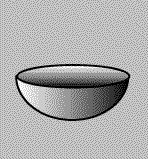 Use
the"reload" or "refresh" button on your
browser to restart the animation.
Use
the"reload" or "refresh" button on your
browser to restart the animation. |
|
This means
that they must be covered with a waterproof glaze before they
can be used to hold liquids. In colonial America, this caused
additional problems, because the most common and accessible
glazes contained lead. Lead is toxic to humans, and can accumulate
in the body even though only small amounts are ingested each
time a lead-glazed container is used. Other potters glazed their
ceramics with tin instead of lead.
The animation
to the left symbolizes the way water seeps through unglazed
earthenware.
|